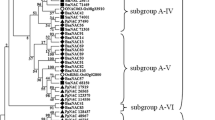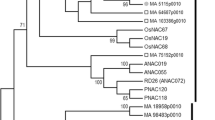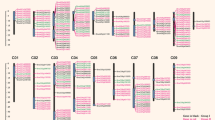Abstract
Subtractive expressed sequence tag analysis and screening of cDNA libraries derived from Brassica napus leaves subjected to mechanical wounding, flea beetle feeding or cold temperatures revealed eight genes encoding NAC-domain transcription factors. The genes were found to be differentially regulated in response to biotic and abiotic stresses including wounding, insect feeding, Sclerotinia sclerotiorum infection, cold shock and dehydration. Five BnNAC proteins were orthologous to Arabidopsis thaliana ATAF1 or ATAF2 and gave rise to developmental abnormalities similar to the A. thaliana nam and cuc mutants when expressed ectopically in A. thaliana. Transgenic lines expressing BnNAC14, exhibited large leaves, thickened stems and hyper-developed lateral root systems similar to that observed with A. thaliana NAC1, but also were delayed in bolting and lacked an apical dominant tap root. Several of the BnNAC proteins were capable of activating gene expression in yeast and recognized an element within the CaMV35S promoter. A yeast two-hybrid screen revealed that BnNAC14 interacted with other select BnNAC proteins in vitro and identified an additional BnNAC gene, BnNAC485. The protein interaction and transcriptional activation domains were mapped by deletion analysis.
Similar content being viewed by others
References
Aida, M., Ishida, T., Fukaki, H., Fujisawa, H. and Tasaka, M. 1997. Genes involved in organ separation in Arabidopsis: an analysis of the cup-shaped cotyledon mutant. Plant Cell 9: 841–857.
Aida, M., Ishida, T. and Tasaka, M. 1999. Shoot apical meristem and cotyledon formation during Arabidopsis embryogenesis: interaction among the CUP-SHAPED COTYLEDON and SHOOT MERISTEMLESS genes. Development 126: 1563–1570.
Baker, B., Zambryski, P., Staskawicz, B. and Dinesh-Kumar, S.P. 1997. Signaling in plant-microbe interactions. Science 276: 726–733.
Baldwin, I.T. and Preston, C.A. 1999. The eco-physiological complexity of plant responses to insect herbivores. Planta 208: 137–145.
Chen, W. and Singh, K.B. 1999. The auxin, hydrogen peroxide and salicylic acid induced expression of the Arabidopsis GST6 promoter is mediated in part by an ocs element. Plant J. 19: 667–677.
Clough, S.J. and Bent, A.F. 1998. Floral dip: a simplified method for Agrobacterium-mediated transformation of Arabidopsis thaliana. Plant J. 16: 735–743.
Cokol, M., Nair, R. and Rost B. 2000. Finding nuclear localization signals. EMBO Rep. 1: 411–415.
Collinge, M. and Boller, T. 2001. Differential induction of two potato genes, Stprx2 and StNAC, in response to infection by Phytophthora infestans and to wounding. Plant Mol. Biol. 46: 521–529.
Dicke, M. and Van Poecke, R.M.P. 2002. Signalling in plant-insect interactions: signal transduction in direct and indirect defence. In: D. Scheel and C. Wasternack (Eds) Frontiers in Molecular Biology: Plant Signal Transduction, Oxford University Press, Oxford, UK, pp. 289–316.
Duval, M., Hsieh, T.F., Kim, S.Y. and Thomas, T.L. 2002. Molecular characterization of AtNAM: a member of the Arabidopsis NAC domain superfamily. Plant Mol. Biol. 50: 237–248.
Greve, K., La Cour, T., Jensen, M.K., Poulsen, F.M. and Skriver, K. 2003. Interactions between plant RING-H2 and plant-specific NAC (NAM/ATAF1/2/CUC2) proteins: RING-H2 molecular specificity and cellular localization. Biochem J. 371: 97–108.
Hammond-Kosack, K.E. and Jones, J.D.G. 1996. Resistance genedependent plant defense responses. Plant Cell 8: 1773–1791.
Hegedus, D.D., Gruber, M.Y., Braun, L. and Khachatourians, G.G. 2002. Genetic engineering and resistance to insects. In: G. Khachatourians, A. McHughen, R. Scorza, W-K. Nip and Y.H. Hui (Eds.) Transgenic Plants and Crops, Marcel Dekker, New York, pp. 249–278.
Hermsmeier, D., Schittko, U. and Baldwin, I.T. 2001. Molecular interactions between the specialist herbivore Manduca sexta (Lepidoptera, Sphingidae) and its natural host Nicotiana attenuata. I. Large-scale changes in the accumulation of growth-and defense-relatedpPlant mRNAs. Plant Physiol. 125: 683–700.
Ishida, T., Aida, M., Takada, S. and Tasaka, M. 2000. Involvement of CUP-SHAPED COTYLEDON genes in gynoecium and ovule development in Arabidopsis thaliana. Plant Cell Physiol. 41: 60–67.
Jin, H. and Martin, C. 1999. Multifunctionality and diversity within the plant MYB-gene family. Plant Mol. Biol. 41: 577–585.
Johnson, P.F., Sterneck, E. and Williams, S.C. 1993. Activation domains of transcriptional regulatory proteins. J. Nutr. Biochem. 4: 386–398.
Li, R., Rimmer, R., Yu, M., Sharpe, A. G., Séguin-Swartz, G., Lydiate, D. and Hegedus, D.D. 2003. Two Brassica napus polygalacturonase inhibitory protein genes are expressed at different levels in response to biotic and abiotic stresses. Planta 217: 299–308.
Kessler, A. and Baldwin, I.T. 2002. Plant responses to insect herbivory: the emerging molecular analysis. Annu. Rev. Plant Biol. 53: 299–328.
Kikuchi, K., Ueguchi-Tanaka, M., Yoshida, K.T., Nagato, Y., Matsusoka, M. and Hirano, H.Y. 2000. Molecular analysis of the NAC gene family in rice. Mol. Gen. Genet. 262: 1047–1051.
Kuhlmann, M., Horvay, K., Strathmann, A., Heinekamp, T., Fischer, U., Bottner, S. and Droge-Laser, W. 2003. The α-helical D1 domain of the tobacco bZIP transcription factor BZI-1 interacts with the ankyrin-repeat protein ANK1 and is important for BZI-1 function, both in auxin signaling and pathogen response. J. Biol. Chem. 278: 8786–8794.
Rechsteiner, M. and Rogers, S.W. 1996. PEST sequences and regulation by proteolysis. Trends Biochem. Sci. 21: 267–271.
Ren, T., Qu, F. and Morris, T.J. 2000. HRT gene function requires interaction between a NAC protein and viral capsid protein to confer resistance to turnip crinkle virus. Plant Cell 12: 1917–1926.
Reymond, P., Weber, H., Damond, M. and Farmer, E.E. 2000. Differential gene expression in response to mechanical wounding and insect feeding in Arabidopsis. Plant Cell 12: 707–720.
Robatzek, S. and Somssich, I.E. 2001. A new member of the Arabidopsis WRKY transcription factor family, AtWRKY6, is associated with both senescence-and defence-related processes. Plant J. 28: 123–133.
Sablowski, R.W. and Meyerowitz, E.M. 1998. A homolog of NO APICAL MERISTEM is an immediate target of the floral homeotic genes APETALA3/PISTILLATA. Cell 92: 93–103.
Schenk, P.M., Kazan, K., Wilson, I., Anderson, J.P., Richmond, T., Somerville, S.C. and Manners, J.M. 2000. Coordinated plant defense responses in Arabidopsis revealed by microarray analysis. Proc. Natl. Acad. Sci. USA 97: 11655–11660.
Singh, K.B., Foley, R.C. and Onate-Sanchez, L. 2002. Transcription factors in plant defense and stress responses. Curr. Opin. Plant Biol. 5: 430–436.
Souer, E., van Houwelingen, A., Kloos, D., Mol, J. and Koes, R. 1996. The no apical meristem gene of Petunia is required for pattern formation in embryos and flowers and is expressed at meristem and primordia boundaries. Cell 85: 159–170.
Souer, E., van Houwelingen, A., Bliek, M., Kloos, D., Mol, J. and Koes, R. 1998. Co-suppression of nam and homologous genes leads to a reduction in axillary meristem formation and increased leaf and stem size in Petunia: a possible role for NAC domain genes in plant development. Flowering Newsl. 26: 36–46.
Sonehouse, R. 2002. The Transactivation Properties and Intracellular Localization Patterns of Arabidopsis TGA Factors. M.Sc. thesis, University of Saskatchewan.
Stotz, H.U., Pittendrigh, B.R., Kroymann, J., Weniger, K., Fritsche, J., Bauke, A. and Mitchell-Olds, T. 2000. Induced plant defense responses against chewing insects. Ethylene signaling reduces resistance of Arabidopsis against Egyptian cotton worm but not diamondback moth. Plant Physiol. 124: 1007–1018.
Stowe, K.A., Marquis, R.J., Hochwender, C.G. and Simms, E.L. 2000. The evolutionary ecology of tolerance to consumer damage. Annu. Rev. Ecol. Syst. 31: 565–595.
Strauss, S.Y. and Agrawal, A.A. 1999. The ecology and evolution of plant tolerance to herbivory. Trends Ecol. Evol. 14: 179–185.
Takada, S., Hibara, K., Ishida, T. and Tasaka, M. 2001. The CUPSHAPED COTYLEDON1 gene of Arabidopsis regulates shoot apical meristem formation. Development 128: 1127–1135.
Tamai, H., Iwabuchi, M. and Meshi, T. 2002. Arabidopsis GARP transcriptional activators interact with the Pro-rich activation domain shared by G-box-binding bZIP factors. Plant Cell. Physiol. 43: 99–107.
Thain, J.F., Doherty, H.M., Bowles, D.J. and Wildon, D.C. 1990. Oligosaccharides that induce proteinase inhibitor activity in tomato plants cause depolarization of tomato leaf cells. Plant Cell Environ. 13: 569–574.
Walling, L.L. 2000. The myriad plant responses to herbivores. J. Plant Growth Regul. 19: 195–216.
Xie, Q., Sanz-Burgos, A.P., Guo, H., Garcia, J.A. and Gutierrez, C. 1999. GRAB proteins, novel members of the NAC domain family, isolated by their interaction with a geminivirus protein. Plant Mol. Biol. 39: 647–656.
Xie, Q., Frugis, G., Colgan, D. and Chua, N.H. 2000. Arabidopsis NAC1 transduces auxin signal downstream of TIR1 to promote lateral root development. Genes Dev. 14: 3024–3036.
Xie, Q., Guo, H.S., Dallman, G., Fang, S., Weissman, A.M. and Chua, N.H. 2002. SINAT5 promotes ubiquitin-related degradation of NAC1 to attenuate auxin signals. Nature 419: 167–170.
Author information
Authors and Affiliations
Corresponding author
Rights and permissions
About this article
Cite this article
Hegedus, D., Yu, M., Baldwin, D. et al. Molecular characterization of Brassica napus NAC domain transcriptional activators induced in response to biotic and abiotic stress. Plant Mol Biol 53, 383–397 (2003). https://doi.org/10.1023/B:PLAN.0000006944.61384.11
Issue Date:
DOI: https://doi.org/10.1023/B:PLAN.0000006944.61384.11




